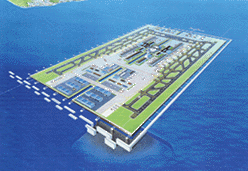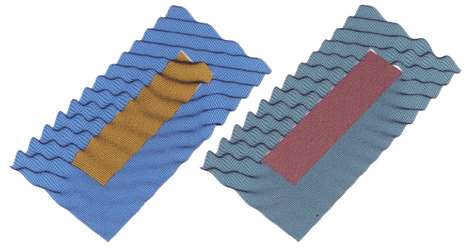

 Very large floating structures (VLFS) are being considered as a new airport, storage and manufacturing facilities, and so on. Studies on their safety and performance in various circumstances are of primary importance in the design. The configuration of VLFS considered here is of pontoon type, and its typical size will be 5 km long, 1 km wide, and only a few meters deep. Therefore this type of structure is featured in that:
Very large floating structures (VLFS) are being considered as a new airport, storage and manufacturing facilities, and so on. Studies on their safety and performance in various circumstances are of primary importance in the design. The configuration of VLFS considered here is of pontoon type, and its typical size will be 5 km long, 1 km wide, and only a few meters deep. Therefore this type of structure is featured in that:
 The equation of elastic motion is solved by adopting the mode-expansion method. The modal functions used are the products of so-called free-free beam modes and the free-end conditions along the edge are satisfied as natural boundary conditions in transforming the stiffness matrix by partial integrations.
The equation of elastic motion is solved by adopting the mode-expansion method. The modal functions used are the products of so-called free-free beam modes and the free-end conditions along the edge are satisfied as natural boundary conditions in transforming the stiffness matrix by partial integrations.
Shown on the left figure are the elastic deflection of a structure of L/B=4 (yellow part) and the wave elevation around the structure (blue part) in a plane progressive wave of L/lambda=10 and incidence angle of 30 degrees.
For comparison, the right figure shows the wave pattern around a rigid plate.
We can see that the wave reflection from the bow part is small and a part of the wave propagates beneath a flexible plate. Furthermore, the wavelength of the elastic wave on a structure is longer than that of the incident wave and the propagation angle bends to the longitudinal direction of the structure.
 Link to
related References
Link to
related References
 Home Page of Free Surface/Interface Dynamics Section
Home Page of Free Surface/Interface Dynamics Section
 Inquiries and comments are weltome at
kashi@riam.kyushu-u.ac.jp
Inquiries and comments are weltome at
kashi@riam.kyushu-u.ac.jp